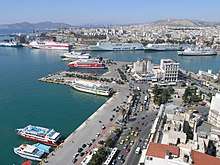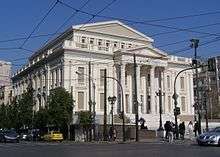Piraeus
The Piraeus (Πειραιάς, official transliteration Pireas) is the ancient port of Athens, and still functions as the chief exit point from the city by sea, for destinations among the Aegean Islands and elsewhere in the east Mediterranean. Domestic destinations include all of the Aegean islands except the Sporades and some smaller Cyclades and Dodecanese isles that require a connection. International destinations (apart from cruise ships) include Cyprus and the Middle East.

Understand
Piraeus occupies a huge territory. Check your gate number in advance so you know where to go. It may take 15 minutes of driving or 30 minutes of walking to reach one end of the port from the other.
Since privatisation of the Port of Piraeus Authority passenger facilities have improved greatly. Air conditioned tents have been set up at departure locations around the port and free wi-fi internet access is now available.
Sailings (arrivals and departures) are posted outside the Coast Guard Building at Karaiskaki Square, the main bus terminal for the Piraeus suburbs. Sailings are also available online from the Ministry of Merchant Marine.
The area can become hectic, especially during the summer period, so allow plenty of time to navigate to the correct departure point.
Get in
Most travellers arriving in Piraeus from central Athens make use of the very convenient Metro. Line 1 terminates at the Port, from there it's a short walk to the Saronic Gulf ferries, hydrofoils and catamarans, or a free shuttle-bus ride to the ships sailing to Crete and the Dodecanses. Central Cyclades ferries conveniently sail from just across the metro station. Metro ticket costs €1.40 and allows unlimited connections on all modes of transport within 90 minutes.
Direct Airport Express buses run 24 hours between the port of Piraeus and Athens International Airport. Allow 90 minutes for the trip. The Airport is also accessible via the Metro, with a connection at Monastiraki. Bus tickets to the airport, available from the driver, cost €5.00; Metro tickets to the airport are €8.00.
Other public buses connect Piraeus with its outlying suburbs, the southern coastal zone and with central Athens. Bus and trolley-bus tickets cost €1.40 and are valid for unlimited connections(including metro) within 90 minutes. They must be bought in advance (generally from kiosks or inside metro stations) and validated once on board.
During the "season", a goodly number of cruise ships stop here. Modest sized ships dock within easy walk of the passenger terminal (approximately a mile south of the Metro station). Large ships dock about 2–300 meters farther away, closer to the busy entrance to this harbor. From the terminal, you could take a taxi, or you might find a city bus going toward the Metro terminal (ask in the terminal); otherwise, you face a walk with entrances to ferry and freight docks on the shore side, and various commercial and civic buildings on the other side of the very busy street. Those walkers who stay on the harbor side can use a pedestrian bridge over the street within sight of the Metro station.
Get around
The centre of Piraeus and the Port can be negoatiated easily on foot if you are not carrying luggage. Yellow trolley buses (trolley bus no 20) are useful for the run from the Port to Passalimani and then follow the very scenic route around the hill of Castella, terminating at the Line 1 Metro station of Neon Phaleron (Neo Faliro), near the Peace & Friendship and Karaiskaki Stadiums.
Free shuttle buses inside the Port run from across the Metro Line 1 Terminal Station, around the north side of the port to the ships sailing for Crete, the Eastern Aegean and the Dodecanese.
See
- 🌍 Archaeological Museum of Piraeus, 31 Ch. Trikoupi Street. Established in 1935 and expanded in 1966, the Piraeus Museum is small in size, yet holds a number of significant pieces in its collection. These included bronze statues of Apollo and Athena from the Archaic and Classical periods of Greek art, as well as a fine collection of funerary stelae.

- 🌍 Municipal Theater of Piraeus, 34 Iroon Polytechniou ave.. Completed in 1895, the Municipal Theater (Greek: Δημοτικό Θέατρο, Dimotiko Theatro) has been a hallmark of Piraeus for over a century. During its extended history it has hosted not only plays featuring renowned actors and music concerts by great composers (Manos Hatzidakis, Mikis Theodorakis and more), but also the Piraeus Municipal Gallery and the Historic Archives. Restoration work was completed in 2013 and the theater is now dedicated to its original purpose of holding theatrical plays.

- 🌍 Piraeus Terminal Station. One of the oldest of its kind in Greece, built on the site of Piraeus's first conventional train station, it was completed in 1929. Its original interior arch design and exterior architecture have been restored before the 2004 Olympic Games. Since 2005 it also houses the Electric Railway Museum.
- 🌍 Zea Marina.
Do
The most important thing to do is to take a ferry to the Greek Islands. You also can have a nice walk in the Pasalimani/Mikrolimano area and look at many amazing yachts and ships.
Another major option is to take the Metro to various parts of Athens (see map of routes on main Athens page). Cost is very modest, and service is very frequent.
- 🌍 Votsalakia Beach.
- 🌍 Freatida Beach.
- 🌍 Karaiskakis Stadium. Olympiacos is one of the most successful clubs of Greek football, having been Greek champions more times than any other club. Their rivalry with Panathinaikos, the Derby of the Eternal Enemies, is widely regarded as one of the most intense in the world.
Buy
The main street for apparel shopping in Piraeus is Sotiros Dios, pedestrainized for the most part and quite nice to walk through, going uphill from the port and the downhill towards the Marina. There are also many shops and cafes along the harbor front, especially toward the cruise terminal and near the Metro station.
Eat
Piraeus offers numerous fish bistros (Greek: psarotaverna) spread along the coastline, especially along Pasalimani and Mikrolimano Bays.
- Delfino Restaurant, 60, Akti Koumoundourou, Mikrolimano, ☎ +30 2104120388. Located in Mikrolimano, a cosy bay with hundreds of sailing boats. Excellent seafood restaurant - try the fresh fish on the grill and fresh lobster with linguini. Warm and professional service. Amazing the indoor and outdoor areas. For mid/high budgets.

Drink
Good cafes are very scarce in the port.
- Coffee Right: next to the metro station, around Piraeus gate E8. Recommended by employees of the port. Cozy place, great pastries and coffee—but unfriendly and sometimes overcomplicated service. Only few speak English, coffee and pastries served (and paid for) from three(!) different counters.
- Bouboulina. At the end of the marina, Bouboulina has an extensive terrace overlooking the open sea. Service is relaxed but rather higher-end and friendly. The drink and food menu has many options to choose from, and while one would come here for the view more for culinary delights, Bouboulina does not disappoint at that front either.

Sleep
- Ionion Hotel. The hotel is run by Mr Takis A. Saxionis, who responds personally to emails. The hotel is a very short walk from the X96 bus drop off, and near to departing ferries. The hotel is an excellent location to spend the night if you're catching an early ferry. Hotel cost is approximately €50 per night for a room for two persons (bathroom en suite). Most rooms have air conditioning and balconies.
- Phidias Piraeus Hotel.
- Piraeus Dream Hotel.
- Piraeus Theoxenia Hotel. The most luxurious hotel in Piraeus, boasting five stars
- Lilia Hotel.
- Scorpios Hotel.
- Faros I.
Stay safe
Piraeus is a rather chaotic place with traffic that's horrendous even for Greece. Particular caution should be used when crossing the street, or when walking along the pavement by the ferry quays where cars, taxis, and trucks often drive randomly among the crowds of travelers walking to and from the boats.
Piraeus is a huge port filled with sailors, and parts of it are about as tough as you'd expect such a place to be. The areas right by the ferry quays are safe enough, but avoid wandering around the rest of Piraeus, especially at night, unless you know your way around.
Unlicensed taxi drivers often meet arriving ferries. Unlike in some countries, these taxis have a bad reputation and should not be considered as a cheap alternative to licensed cabs.
Pickpocketing gangs have been reported working on the Piraeus-Airport bus; for a full description see the Athens Stay Safe section.
One scam you may encounter in Piraeus is a rather subtle one. A man will walk up to you while you are waiting with your luggage in line to board a ferry. This gentleman is a consummate actor: though he doesn't actually claim to be working for the boat or port, his demeanor and behavior imply strongly that he is. He'll pick up your luggage, brushing aside any objections, and usher you with it to the head of the line, at which point he'll demand a hefty tip. In one reported case the bite was €7.00 (our respondent decided the performance was worth €2.00)
Go next
Piraeus is the largest port of Greece, which means that you have a large variety of destinations to choose from. From here flying dolphins and ships leave for the Saronic Gulf Islands (Gate Ε8), high speed catamarans and conventional ferries for the Aegean Islands (Gates E6,E7,E9,E10), ferries and cruise ships for Crete, Lesvos, Chios and the Dodecanese ( Gates E3, E2 and Gate E1 respectively) and bigger vessels for Cyprus and the Middle East (Gates E11,E12). Most major Greek Naval Companies have agencies here.